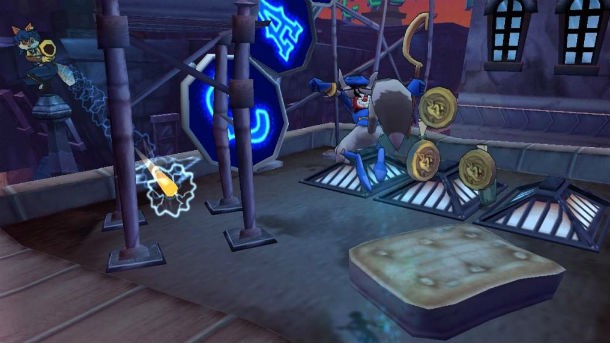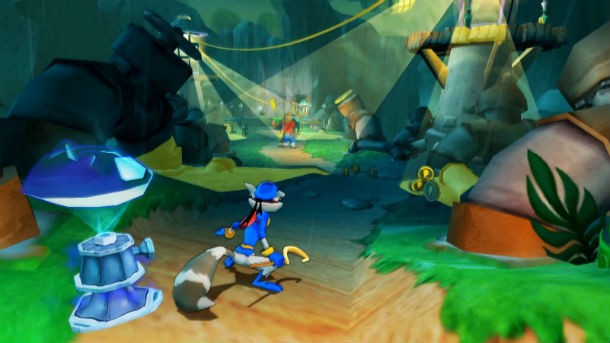Please support Game Informer. Print magazine subscriptions are less than $2 per issue
Celebrating 15 Years Of Sly Cooper, Sony's Most Stylish Mascot

Sneaking from the shadows, a cane-wielding raccoon gracefully leaps across Parisian rooftops backlit by the greens and pinks of neon signs, his footsteps locked to the rhythm of lounge jazz piano.
This opening scene from Sucker Punch's Sly Cooper and the Thievius Racoonus is an indelible image for gamers, one that, much like the game itself, has kept its style and wit over the years. The Thievius Racoonus celebrates its 15th anniversary this year, and revisiting the game after all that time, it’s still clear why Sly’s first adventure was so special and creatively risky.
In September 2002, the 3D platformer genre was on a hot streak, especially on Sony consoles. Naughty Dog hit a goldmine with Crash Bandicoot back in 1996, and in late 2001 they released Jak and Daxter to widespread critical and commercial success. It would be another year before Sony’s other 3D platforming behemoths – Sly Cooper and Ratchet & Clank – released.
All these games are still fan favorites, but revisiting Sly Cooper and the Thievius Racoonus revealed a game that is still fun to play and holds up even after 15 years of progress in game design. A large part of that can be attributed to the bold stylistic direction Sucker Punch took with the Thievius Racoonus.

With Jak and Daxter, Naughty Dog built a mysterious world in a cartoonish visual style. In Ratchet & Clank, Insomniac created a gun-filled science-fiction-meets- Pixar universe. Both games had something that young gamers, the target demographic, could latch onto.
With its anthropomorphic animals and cartoon sensibilities, Thievius Racoonus was clearly made with younger players in mind. Sly and the rest of the gang – Bentley the turtle, a germophobic techno genius, and Murray the hippo, the gang’s clumsy but lovable getaway driver – fall into archetypes kids can enjoy. However, Sucker Punch used those characters to tell a revenge story that pulled from classic noir and heist films, genres that its young target demographic might not be familiar with.
Players watch Sly retell the story of his father’s death at the hands of the villainous Fiendish Five in the first of the game’s many playful cartoon cutscenes. Although Sucker Punch plays it off with charm and witty writing, it’s a dark, tragic note to start an adventure on, and a sign that the game isn’t afraid to root itself in more mature thematic territory. Look carefully and you’ll find references to steroids and gambling throughout the Thievius Racoonus. Even Sly’s extremely flirtatious relationship with vulpine cop Carmelita Fox is more mature than most E-rated games. It’s not the most risqué material, but for an E-rated game in 2002, the Thievius Racoonus was pushing more mature interactions and themes for the sake of its noir-lite adventure.
The Thievius Racoonus’ other strengths – the smooth animation and platforming, and moody soundtrack – all contribute to Sucker Punch’s unique vision, but its cel-shaded look is what made it stand out the most among its direct competitors. Its visuals, which hold up surprisingly well, play with shadow and light much like film noir of the 1940s. Laser grids and guards with flashlights are both platforming obstacles for the player and visual contrast for certain levels.

Although 3D platformers aren’t as popular today as they used to be, the way Sly jumps and climbs are reminders of why this genre worked in the first place. Sucker Punch made a smooth, slick platformer that really makes you feel like a master thief. Like any great title, the gameplay works in concert with the narrative. Sly’s movements are a great window into his charming and, well, sly personality even as his actions prove there’s a thrill-seeking intensity beneath that calm and collected surface. The music provided a diverse sonic landscape that keyed into the rhythm of Sly’s thieving hijinks and fit the distinct feel of the game. Whether it was sensual lounge jazz, bombastic electric blues, or atmospheric voodoo swamp drone, the music helped immerse players in Sly’s cartoon noir world.
It’s still impressive how all this locks in place right from the start, particularly in one memorable scene that tasks players with breaking into a vent and jumping through a laser security system. It’s a moment straight out of Mission Impossible. Sly’s graceful animations, the contrast between the dazzling laser display and dark Paris night, and subtle but tense music all work together to make a strong and lasting impression.
That said, video games have come a long way in 15 years, which means not everything in the Thievius Racoonus has aged as gracefully as its visual style.

The tutorials, a product of game design philosophies at the time, find Sly’s techno wiz friend Bentley spouting off control schemes rather than natural dialogue. Non-platforming sections peppered throughout Sly’s adventure certainly helped change up the action, but racing and on-rail shooting levels are more often frustrating than fun.
However, the game’s biggest failure is its depiction of Carmelita Fox as an overly sexualized lust object. Carmelita Fox’s fiery relationship with Sly develops throughout the three main Sly Cooper games in interesting ways, but in the Thievius Racoonus, Sucker Punch remains mired in adolescent – and frequently offensive – depictions of its primary female character.
It’s not enough to completely ruin Sly’s 15-year legacy, but it’s a reminder of where video games were – and sometimes still are – as a medium.
Despite all that, Sly Cooper and the Thievius Racoonus is still a stylish, fun, and surprisingly mature experience even after 15 years. The cartoon, anthropomorphized noir that Sucker Punch delivered back in 2002 spawned three sequels that expanded the Sly Cooper universe, refined stealth, and moved the series towards open world-like levels with multi-stage heist missions. Although later games were bigger the Thievius Racoonus is the reason Sly Cooper remains Sony’s most stylish mascot.










